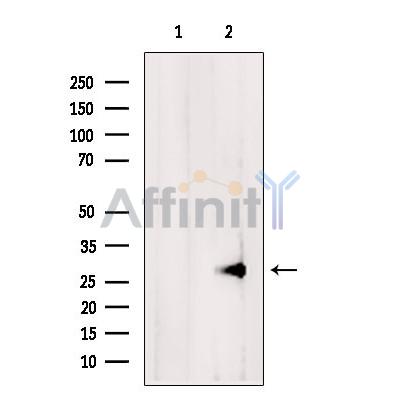APRIL/TNFSF13 Antibody - #DF6369
| Product: | APRIL/TNFSF13 Antibody |
| Catalog: | DF6369 |
| Description: | Rabbit polyclonal antibody to APRIL/TNFSF13 |
| Application: | WB IHC IF/ICC |
| Reactivity: | Human, Mouse, Rat |
| Prediction: | Pig, Bovine, Sheep, Dog |
| Mol.Wt.: | 27kDa; 27kD(Calculated). |
| Uniprot: | O75888 |
| RRID: | AB_2838333 |
Related Downloads
Protocols
Product Info
*The optimal dilutions should be determined by the end user. For optimal experimental results, antibody reuse is not recommended.
*Tips:
WB: For western blot detection of denatured protein samples. IHC: For immunohistochemical detection of paraffin sections (IHC-p) or frozen sections (IHC-f) of tissue samples. IF/ICC: For immunofluorescence detection of cell samples. ELISA(peptide): For ELISA detection of antigenic peptide.
Cite Format: Affinity Biosciences Cat# DF6369, RRID:AB_2838333.
Fold/Unfold
A proliferation inducing ligand; A proliferation-inducing ligand; APRIL; CD256; TALL-2; TALL2; TNF related death ligand; TNF- and APOL-related leukocyte expressed ligand 2; TNF-related death ligand 1; TNF13_HUMAN; TNFSF13; TRDL-1; TRDL1; Tumor necrosis factor (ligand) superfamily, member 13; Tumor necrosis factor ligand superfamily member 13; Tumor necrosis factor like protein ZTNF2; Tumor necrosis factor related death ligand 1; UNQ383/PRO715; ZTNF2;
Immunogens
A synthesized peptide derived from human APRIL/TNFSF13, corresponding to a region within the internal amino acids.
Expressed at high levels in transformed cell lines, cancers of colon, thyroid, lymphoid tissues and specifically expressed in monocytes and macrophages.
- O75888 TNF13_HUMAN:
- Protein BLAST With
- NCBI/
- ExPASy/
- Uniprot
MPASSPFLLAPKGPPGNMGGPVREPALSVALWLSWGAALGAVACAMALLTQQTELQSLRREVSRLQGTGGPSQNGEGYPWQSLPEQSSDALEAWENGERSRKRRAVLTQKQKKQHSVLHLVPINATSKDDSDVTEVMWQPALRRGRGLQAQGYGVRIQDAGVYLLYSQVLFQDVTFTMGQVVSREGQGRQETLFRCIRSMPSHPDRAYNSCYSAGVFHLHQGDILSVIIPRARAKLNLSPHGTFLGFVKL
Predictions
Score>80(red) has high confidence and is suggested to be used for WB detection. *The prediction model is mainly based on the alignment of immunogen sequences, the results are for reference only, not as the basis of quality assurance.
High(score>80) Medium(80>score>50) Low(score<50) No confidence
Research Backgrounds
Cytokine that binds to TNFRSF13B/TACI and to TNFRSF17/BCMA. Plays a role in the regulation of tumor cell growth. May be involved in monocyte/macrophage-mediated immunological processes.
The precursor is cleaved by furin.
Secreted.
Expressed at high levels in transformed cell lines, cancers of colon, thyroid, lymphoid tissues and specifically expressed in monocytes and macrophages.
Belongs to the tumor necrosis factor family.
Research Fields
· Environmental Information Processing > Signaling molecules and interaction > Cytokine-cytokine receptor interaction. (View pathway)
· Human Diseases > Immune diseases > Rheumatoid arthritis.
· Organismal Systems > Immune system > Intestinal immune network for IgA production. (View pathway)
Restrictive clause
Affinity Biosciences tests all products strictly. Citations are provided as a resource for additional applications that have not been validated by Affinity Biosciences. Please choose the appropriate format for each application and consult Materials and Methods sections for additional details about the use of any product in these publications.
For Research Use Only.
Not for use in diagnostic or therapeutic procedures. Not for resale. Not for distribution without written consent. Affinity Biosciences will not be held responsible for patent infringement or other violations that may occur with the use of our products. Affinity Biosciences, Affinity Biosciences Logo and all other trademarks are the property of Affinity Biosciences LTD.


